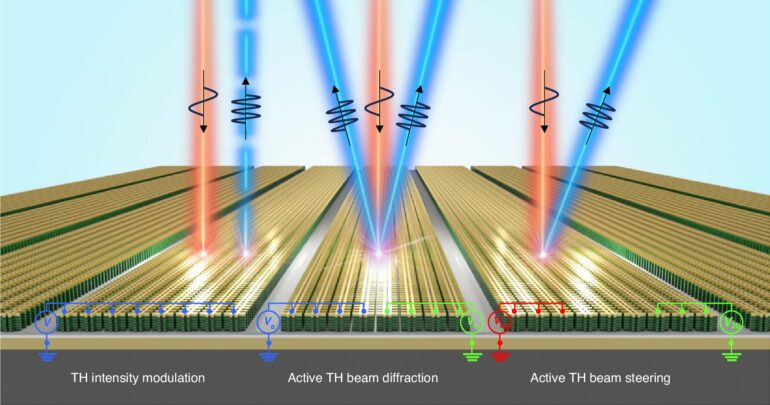A recent study has unveiled a transformative nonlinear optical metasurface technology. This new technology, characterized by structures smaller than the wavelength of light, paves the way for significant advancements in next-generation communication technologies, including quantum light sources and medical diagnostic devices.
For the first time, the researchers produced experimental implementations of electrically tunable third-harmonic generation (THG) using an intersubband polaritonic metasurface combined with multiple quantum wells (MQWs). The work is published in Light: Science & Applications and was led by Professor Jongwon Lee in the Department of Electrical Engineering at UNIST.
Notably, they achieved a remarkable 450% modulation depth of the THG signal and an 86% suppression of zero-order THG diffraction, with local phase tuning exceeding 180 degrees. Additionally, they demonstrated THG beam steering utilizing phase gradients, proposing a new pathway for electrically adjustable flat nonlinear optical elements with versatile functionalities.
Nonlinear optics, which explores the interaction between light and matter, can generate multiple wavelengths from a single light source, significantly enhancing information transmission compared to traditional single-wavelength lasers. A widely recognized example of nonlinear optical technology is the green laser pointer.
The innovative nonlinear optical metasurface created by Professor Lee’s team allows for the development of compact and lightweight optical instruments, with laser devices possibly as thin as paper and utilizing materials even thinner than a human hair. While prior methods struggled with electrical control, this new metasurface can be easily modulated, making it a game changer in the field.
Notably, the team has introduced the world’s first technology that allows for voltage control of second-harmonic generation (SHG) and achieved independent modulation of the intensity and phase of THG, enabling the metasurface to control not only the wavelength but also the intensity and phase of light.
“This advancement allows for unprecedented control of light,” said Professor Lee. “By adjusting the intensity and phase of nonlinear THG through electrical means, we open new avenues for applications in light modulation for cryptography, dynamic holography, next-generation quantum sensors, and quantum communication light sources.”
Researcher Seongjin Park stated, “The properties of our optical metasurface are defined by the semiconductor layer and metal structure. We have overcome previous limitations by enabling adjustments to light’s phase, amplitude, and frequency.”
More information:
Seongjin Park et al, Electrically tunable third-harmonic generation using intersubband polaritonic metasurfaces, Light: Science & Applications (2024). DOI: 10.1038/s41377-024-01517-y
Provided by
Ulsan National Institute of Science and Technology
Citation:
Nonlinear optical metasurface achieves electrically tunable third-harmonic generation (2024, September 27)



